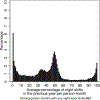Night and rotational work exposure within the last 12 months and risk of incident hypertension
- PMID: 30614503
- PMCID: PMC6494694
- DOI: 10.5271/sjweh.3788
Night and rotational work exposure within the last 12 months and risk of incident hypertension
Abstract
Objectives Shift work, such as alternating day and nights, causes chronobiologic disruptions which may cause an increase in hypertension risk. However, the relative contributions of the components of shift work ‒ such as shift type (eg, night work) and rotations (ie, switching of shift times; day to night) ‒ on this association are not clear. To address this question, we constructed novel definitions of night work and rotational work and assessed their associations with risk of incident hypertension. Methods A cohort of 2151 workers at eight aluminum manufacturing facilities previously studied for cardiovascular disease was followed from 2003 through 2013 for incident hypertension, as defined by ICD-9 insurance claims codes. Detailed time-registry data was used to classify each worker's history of rotational and night work. The associations between recent rotational work and night work in the last 12 months and incident hypertension were estimated using adjusted Cox proportional hazards models. Results Elevated hazard ratios (HR) were observed for all levels of recent night work (>0-5, >5-50, >50-95, >95-100%) compared with non-night workers, and among all levels of rotational work (<1, 1-10, >10-20, >20-30, and >30%) compared with those working <1% rotational work. In models for considering the combination of night and rotational work, workers with mostly night work and frequent rotations (≥50% night and ≥10% rotation) had the highest risk of hypertension compared to non-night workers [HR 4.00, 95% confidence interval (CI )1.69-9.52]. Conclusions Our results suggest recent night and rotational work may both be associated with higher rates of incident hypertension.
Conflict of interest statement
Conflicts of interest
Dr Mark Cullen has received salary support from Alcoa, Inc. (Pittsburgh, Pennsylvania) through contracts with Stanford University (Stanford, California). The other authors report no conflicts of interest.
Figures




References
-
- Lu K, Chen J, Wang L, Wang C, Ding R, Wu S et al. Association of sleep duration, sleep quality and shiftwork schedule in relation to hypertension prevalence in chinese adult males: A cross-sectional survey. Int J Environ Res Public Health 2017. February;14(2):pii: E210 10.3390/ijerph14020210. - DOI - PMC - PubMed
-
- Straif K, Baan R, Grosse Y, Secretan B, Ghissassi F, Bouvard V. IARC Monographs on the Evaulation of Carcinogenic Risks to Humans. 2007.

